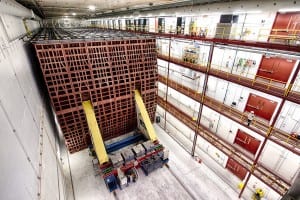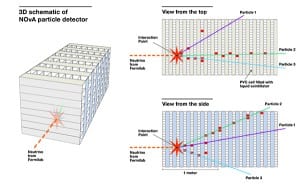Scientists have sorted through millions of cosmic ray strikes and zeroed in on neutrino interactions in their quest to learn more about the abundant yet mysterious particles that flit through ordinary matter as though it isn’t there.
Initial data from a new U.S.–based physics experiment indicates scientists are a step closer to understanding neutrinos, the second most abundant particle in the universe.
Neutrinos are little understood, but indications are they hold clues to why matter overwhelmingly survived after the Big Bang instead of just energy in the form of light.
The first data from NOvA, the experiment in northern Minnesota, indicates that NOvA’s massive particle detector — designed to observe and measure the behavior of neutrinos — is functioning as planned.
“In the 18 or so months the experiment has been up and running we’ve analyzed about 8 percent of the data we anticipate collecting over the life of the experiment,” said physicist Thomas Coan, Southern Methodist University, Dallas.
Coan, a professor in SMU’s Department of Physics, is a principal investigator on NOvA, a collaboration of the U.S. Department of Energy’s Fermi National Laboratory. “So we’re really just at the beginning. But it’s a great start, and it’s gratifying that the beginning has begun so well.”
More than 200 scientists from the U.S. and six other countries make up the collaboration.
Specifically, they predict that the experiment’s data will tell them the relative weight of the three different types or “flavors” of neutrinos, as well as reveal whether neutrinos and antineutrinos interact in the same way.
Answers to those questions will add information to theories of matter’s existence and why it wasn’t annihilated during the Big Bang, Coan said.

“If we want to understand the universe on a large scale, we have to understand how neutrinos behave,” he said. “Experimental observations from NOvA will be an important input into the overarching theory.”
Neutrinos flit through ordinary matter almost as if it weren’t there, so it takes a massive detector to capture evidence of their behavior. Coan likens NOvA to a gigantic pixel camera with its honeycomb array of thousands of plastic tubes encasing highly purified mineral oil.
Neutrinos are not observed directly, so scientists only see the tracks of their rare interactions with atoms. An accelerator at Fermilab in Illinois shoots a neutrino beam, observed first by a near detector there, then by a far detector some 500 miles away in Minnesota.
The far detector, or “pixel camera,” is 50 feet tall by 50 feet wide and 200 feet long.
Oscillating neutrinos change from one “type” to another: electron, muon or tau
As the neutrinos travel they change from one type or “flavor” to another. That “oscillation” confirms the NOvA detector is functioning as designed.
The first NOvA results were released this week at the American Physical Society’s Division of Particles and Fields conference in Ann Arbor, Mich.
[/fusion_builder_column][fusion_builder_column type=”1_1″ background_position=”left top” background_color=”” border_size=”” border_color=”” border_style=”solid” spacing=”yes” background_image=”” background_repeat=”no-repeat” padding=”” margin_top=”0px” margin_bottom=”0px” class=”” id=”” animation_type=”” animation_speed=”0.3″ animation_direction=”left” hide_on_mobile=”no” center_content=”no” min_height=”none”]

The results were culled by scientists who sorted through millions of cosmic ray strikes to zero-in on neutrino interactions.
“People are ecstatic to see our first observation of neutrino oscillations,” said NOvA co-spokesperson Peter Shanahan, Fermilab. “For all the people who worked over the course of a decade on the designing, building, commissioning, and operating this experiment, it’s beyond gratifying.”
Researchers have collected data aggressively since February 2014, recording neutrino interactions in the 14,000-ton far detector in Ash River, Minnesota, while construction was still underway. This allowed the collaboration to gather data while testing systems before starting operations with the complete detector in November 2014, shortly after the experiment was completed on time and under budget. NOvA construction and operations are supported by the DOE’s Office of Science.
The neutrino beam generated at Fermilab passes through the underground near detector, which measures the beam’s neutrino composition before it leaves the Fermilab site.
The particles then travel more than 500 miles straight through the earth, changing types along the way. About once per second, Fermilab’s accelerator sends trillions of neutrinos to Minnesota, but the elusive neutrinos interact so rarely that only a few will register at the far detector.
Neutrino-atom interaction releases a signature trail of particles and light
The beam fires neutrinos every 1.5 seconds, but only for 10 microseconds, Coan said. Including downtime for maintenance, neutrinos are produced two minutes total over the course of a year.
“We could make the detector out of iron or granite to get more target atoms and have more interactions, but we’d never be able to observe the interactions in iron and granite,” Coan said. “So the detector has to be transparent somehow, a sort of camera. Those two goals are somewhat contradictory. So it takes some cleverness to figure out how to have a massive detector and still see events in it.”
When a neutrino bumps into an atom in the NOvA detector, it releases a signature trail of particles and light depending on which type it is: an electron, muon or tau neutrino. The beam originating at Fermilab is made almost entirely of one type – muon neutrinos – and scientists can measure how many of those muon neutrinos disappear over their journey and reappear as electron neutrinos.
If oscillations had not occurred, experimenters predicted they would see 201 muon neutrinos arrive at the NOvA far detector in the data collected; instead, they saw a mere 33, proof that the muon neutrinos were disappearing as they transformed into the two other flavors
Similarly, if oscillations had not occurred scientists expected to see only one electron neutrino appearance, due to background interactions, but the collaboration saw six such events, which is evidence that some of the missing muon neutrinos had turned into electron neutrinos.
NOvA observations are nearly equivalent results to those at world’s other neutrino experiments
Similar long-distance experiments such as T2K in Japan and MINOS at Fermilab have seen these muon neutrino-to-electron neutrino oscillations before. NOvA, which will take data for at least six years, is seeing nearly equivalent results in a shorter time frame, something that bodes well for the experiment’s ambitious goal of measuring neutrino properties that have eluded other experiments so far.
“One of the reasons we’ve made such excellent progress is because of the impressive Fermilab neutrino beam and accelerator team,” said NOvA co-spokesperson Mark Messier of Indiana University. “Having a beam of that power running so efficiently gives us a real competitive edge and allows us to gather data quickly.”
Fermilab’s flagship accelerator recently set a high-energy neutrino beam world record when it reached 521 kilowatts, and the laboratory is working on improving the neutrino beam even further for projects such as NOvA and the upcoming Deep Underground Neutrino Experiment. Researchers expect to reach 700 kilowatts early next calendar year, accumulating a slew of neutrino interactions and tripling the amount of data recorded by year’s end.
Most abundant massive particle in the universe is still poorly understood
Neutrinos are the most abundant massive particle in the universe, but are still poorly understood. While researchers know that neutrinos come in three types, they don’t know which is the heaviest and which is the lightest. Figuring out this ordering — one of the goals of the NOvA experiment — would be a great litmus test for theories about how the neutrino gets its mass.
While the famed Higgs boson helps explain how some particles obtain their masses, scientists don’t know yet how the Higgs is connected to neutrinos, if at all.
The measurement of the neutrino mass hierarchy is also crucial information for neutrino experiments trying to see if the neutrino is its own antiparticle.
Like T2K, NOvA can also run in antineutrino mode, opening a window to see whether neutrinos and antineutrinos are fundamentally different. An asymmetry early in the universe’s history could have tipped the cosmic balance in favor of matter, making the world we see today possible. Soon, scientists will be able to combine the neutrino results obtained by T2K, MINOS and NOvA, yielding more precise answers about scientists’ most pressing neutrino questions.
“The rapid success of the NOvA team demonstrates a commitment and talent for taking on complex projects to answer the biggest questions in particle physics,” said Fermilab Director Nigel Lockyer. “We’re glad that the detectors are functioning beautifully and providing quality data that will expand our understanding of the subatomic realm.”
The NOvA collaboration comprises 210 scientists and engineers from 39 institutions in the United States, Brazil, the Czech Republic, Greece, India, Russia and the United Kingdom. — Fermi National Laboratory, SMU
NOvA stands for NuMI Off-Axis Electron Neutrino Appearance. NuMI is itself an acronym, standing for Neutrinos from the Main Injector, Fermilab’s flagship accelerator. The Fermilab Accelerator Complex is an Office of Science User Facility.
For more information, visit the NOvA web site.
Watch live particle events recorded by the NOvA experiment.
Learn how the NOvA detector sees neutrinos.
Follow the experiment on Facebook and Twitter, @novaexperiment.
Follow SMUResearch.com on Twitter, @smuresearch.
SMU is a nationally ranked private university in Dallas founded 100 years ago. Today, SMU enrolls nearly 11,000 students who benefit from the academic opportunities and international reach of seven degree-granting schools. For more information see www.smu.edu.
Fermilab is America’s premier national laboratory for particle physics and accelerator research. A U.S. Department of Energy Office of Science laboratory, Fermilab is located near Chicago, Ill., and operated under contract by the Fermi Research Alliance LLC. Visit Fermilab’s website at www.fnal.gov, and follow Fermilab on Twitter at @Fermilab.
The DOE Office of Science is the single largest supporter of basic research in the physical sciences in the United States and is working to address some of the most pressing challenges of our time. For more information, please visit science.energy.gov.
SMU has an uplink facility located on campus for live TV, radio, or online interviews. To speak with an SMU expert or book an SMU guest in the studio, call SMU News & Communications at 214-768-7650.
